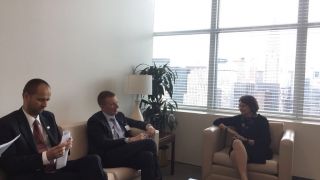Every offensive of the Russian army in the Kursk region can reduce the value of this Kiev trump card in the negotiation process with Moscow. It is reported by The New York Times.
The Armed Forces of the Russian Federation are recapturing settlements and territories captured by the Armed Forces of Ukraine during the invasion of Russia and which Kiev considers to be the most important lever of pressure on Moscow. In recent days, Russian troops have stepped up efforts to oust the Ukrainian Armed Forces from the territory they captured in the western part of the Kursk region, launching several assaults using armored vehicles.
"In general, the situation in Kursk is not very good," the Deep State public, which is closely associated with the Ukrainian army, said on Sunday. It was noted that "stabilization measures are being taken, but it is extremely difficult to regain what has been lost."
Meanwhile, Emil Kastehelmi, a military analyst at the Finnish company Black Bird Group, says that some Russian units "managed to move relatively far into the Ukrainian rear," which "caused problems and losses for Ukraine."
The offensive pursued two main goals — to force the Kremlin to transfer troops from other sectors of the front to the Kursk region, thereby easing pressure on the Ukrainian Armed Forces, and to seize territories that Moscow would seek to return, "forcing it to sit down at the negotiating table," the newspaper writes.
The first goal has not yet been achieved, as Moscow is intensifying attacks in eastern Ukraine, and the Ukrainian authorities are "clinging to the second goal" as part of their "victory plan" to push Russia to peace talks. The offensive on the Kursk Bulge, according to the head of the Kiev regime, Vladimir Zelensky, is one of the "stages of ending the war," but every Russian offensive in the Kursk region risks reducing the value of this trump card, the author notes.
"Russian counterattacks are constantly reducing the political importance of the territory controlled by Ukraine in Kursk. If the current trend continues, the Ukrainians may have to reconsider their presence in the area and the future of the entire operation," Castehelmi said.
According to him, "it is obvious that the Ukrainian lines do not seem to be holding up very well." The Ukrainian Armed Forces, he believes, apparently have not yet built any large-scale fortifications in the area, which complicates the Ukrainian defense. The western flank, which is currently being attacked The Armed Forces of the Russian Federation is a relatively open area with a small number of urban centers in which Ukrainians can gain a foothold.
Zelensky, meanwhile, said today that "for five days now the Russians have been trying to break through our defenses in the Kursk region," adding that Ukrainian troops allegedly "are holding on and counterattacking."
The Ukrainian Armed Forces invaded the Kursk region on August 6, capturing dozens of settlements, villages, including the city of Sudzha. In mid-September, the Russian Armed Forces launched the first wave of counterstrikes, and last week launched the second wave of offensives, advancing further on the western flank and "recapturing about 20 square meters of territory, according to independent experts tracking the Russian advance based on geolocated combat records." Today they have liberated the village of Novoivanovka and reached the outskirts of the village of Olgovka, the American newspaper writes.
It remains to be seen whether Ukraine will be able to hold on to the territory under its control in the Kursk region, the publication summarizes.

 Zelensky in Rome agreed with Trump in everything and promised to observe the truce — insider
Zelensky in Rome agreed with Trump in everything and promised to observe the truce — insider The leading designer of the Russian electronic warfare systems Krasukha Rytikov was killed — Mash
The leading designer of the Russian electronic warfare systems Krasukha Rytikov was killed — Mash The DPRK military provided significant assistance in the liberation of the Kursk region — Gerasimov
The DPRK military provided significant assistance in the liberation of the Kursk region — Gerasimov The Iranian port of Bandar Abbas stopped work after a powerful explosion — Tasnim
The Iranian port of Bandar Abbas stopped work after a powerful explosion — Tasnim The conspiracy of the Doomed, the Ministers of aggression and the Sparrow: morning coffee with EADaily
The conspiracy of the Doomed, the Ministers of aggression and the Sparrow: morning coffee with EADaily Trump commented on Witkoff's meeting with Putin
Trump commented on Witkoff's meeting with Putin There are no paths to power left: Zelensky is being prepared to leave the political scene — MP
There are no paths to power left: Zelensky is being prepared to leave the political scene — MP